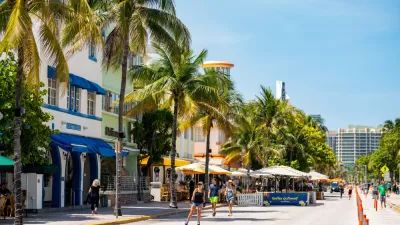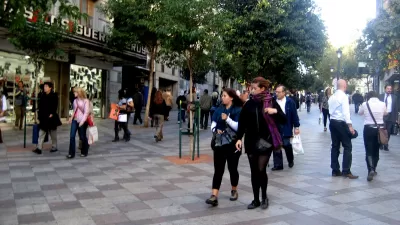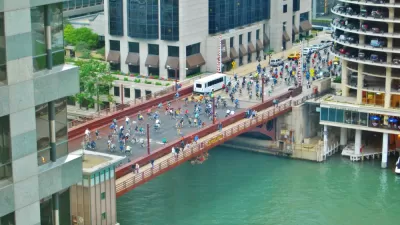"Slow streets" is a popular concept, but residents and community advocates say officials have to do more to make implementation effective and equitable.

With restricted access to most indoor spaces, the humble street got a lot of attention over the last year as cities reallocated right-of-way to pedestrians and public seating. Liz Farmer of the Lincoln Institute of Land Policy writes about Washington, D.C.'s experiment with "slow streets," a program which included 26 miles of road in the district. "While the concept of slow streets was generally well received," Farmer says, "its implementation in Washington and other cities was sometimes rocky—and sparked much-needed discussions about equity, access, and planning."
At a public hearing, residents expressed support for the concept, but disappointment at the execution. "Concerns included a lack of connectivity—among the slow streets themselves and between the streets and other destinations—as well as logistical aspects like traffic enforcement and signage." Residents also expressed concern that communities of color are being left out of the programs, partly due to local mistrust of programs seen as harbingers of displacement.
"The lessons surfacing in DC, which cover issues ranging from transportation inequities to signage logistics, could also be valuable to other cities that are initiating or expanding slow streets projects this year, from Nashville, Tennessee, to Omaha, Nebraska." One important lesson, according to Jessie Grogan, associate director of Reduced Poverty and Spatial Inequality at the Lincoln Institute, "is that cities need to be more intentional about the purpose of the streets in the first place—then design accordingly. 'If you want to get people from point A to B without getting in cars, then how do you do that safely for people walking or biking?'"
FULL STORY: Lessons from Washington, DC's Experiment with Slow Streets

Alabama: Trump Terminates Settlements for Black Communities Harmed By Raw Sewage
Trump deemed the landmark civil rights agreement “illegal DEI and environmental justice policy.”

Planetizen Federal Action Tracker
A weekly monitor of how Trump’s orders and actions are impacting planners and planning in America.

The 120 Year Old Tiny Home Villages That Sheltered San Francisco’s Earthquake Refugees
More than a century ago, San Francisco mobilized to house thousands of residents displaced by the 1906 earthquake. Could their strategy offer a model for the present?

In Both Crashes and Crime, Public Transportation is Far Safer than Driving
Contrary to popular assumptions, public transportation has far lower crash and crime rates than automobile travel. For safer communities, improve and encourage transit travel.

Report: Zoning Reforms Should Complement Nashville’s Ambitious Transit Plan
Without reform, restrictive zoning codes will limit the impact of the city’s planned transit expansion and could exclude some of the residents who depend on transit the most.

Judge Orders Release of Frozen IRA, IIJA Funding
The decision is a victory for environmental groups who charged that freezing funds for critical infrastructure and disaster response programs caused “real and irreparable harm” to communities.
Urban Design for Planners 1: Software Tools
This six-course series explores essential urban design concepts using open source software and equips planners with the tools they need to participate fully in the urban design process.
Planning for Universal Design
Learn the tools for implementing Universal Design in planning regulations.
Clanton & Associates, Inc.
Jessamine County Fiscal Court
Institute for Housing and Urban Development Studies (IHS)
City of Grandview
Harvard GSD Executive Education
Toledo-Lucas County Plan Commissions
Salt Lake City
NYU Wagner Graduate School of Public Service





























